Teaching your canine companion new and exciting Dog Tricks To Train Your Dog is a fantastic way to strengthen your bond, provide mental stimulation, and showcase your dog’s impressive abilities. Beyond the sheer enjoyment, mastering these fun and engaging tricks offers significant benefits for your dog’s cognitive development and physical fitness. From simple cues to more intricate routines, trick training builds confidence, sharpens communication, and can even contribute to achieving prestigious AKC Trick Dog titles.
To embark on this rewarding journey of training your dog in various tricks, you’ll need a few essential tools: ample patience, dedicated time, high-value dog treats that motivate your dog, and their favorite toys if they’re toy-driven. A clicker can also be incredibly useful for precise marking of desired behaviors. Always ensure you have a quiet, distraction-free environment to optimize your training sessions and help your dog focus. Dive into our comprehensive guide and discover a world of cool things to train your dog to do, transforming everyday moments into extraordinary displays of skill and companionship.
How to Teach Your Dog to Catch
Teaching your dog to catch is a basic yet rewarding trick that builds coordination and focus. Begin with your dog seated in front of you, capturing their attention with a tempting treat. Gently toss the treat with an underhanded motion, aiming for their mouth. If your dog successfully catches the treat, offer enthusiastic praise. If they miss, try to quickly pick up the treat before they can eat it off the ground, then reset and try again.
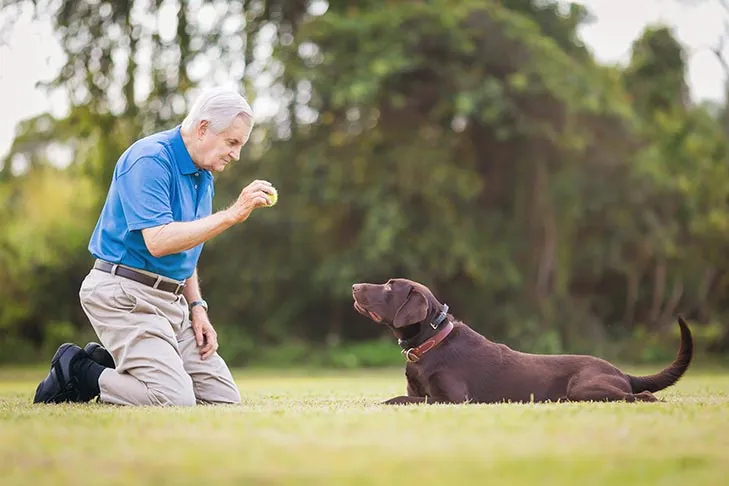 A happy Labrador Retriever looks up, ready to catch a tennis ball held by an older man's hand.
A happy Labrador Retriever looks up, ready to catch a tennis ball held by an older man's hand.
Repeat this exercise a few times during each short training session. Once your dog consistently catches tossed treats, gradually introduce lightweight, soft toys they enjoy. Celebrate each successful catch with plenty of praise, followed immediately by a treat reward.
How to Teach Your Dog “Under the Bridge”
The “under the bridge” trick involves your dog crawling beneath your raised knees, forming a bridge shape. Have your dog’s favorite treats or a coveted toy ready to ensure their motivation. Sit on the floor with your knees bent and raised, creating a triangular tunnel. Position your dog on one side of your body. Hold the treat or toy in your hand on the opposite side and reach it under your legs, allowing your dog to sniff it.
Slowly lower the treat or toy towards the ground, moving it gradually under your legs. As your dog follows the lure, they will naturally lower their body and crawl through the “bridge.” As soon as they emerge on the other side, shower them with praise and reward them with the treat or toy.
After several successful repetitions, you can begin to add a verbal cue, such as “under” or “bridge,” as your dog moves through. When your dog consistently performs the trick in response to the lure and cue, you can start to phase out the physical lure. Eventually, your dog should perform the trick simply by hearing your verbal cue, earning immediate praise and a treat upon completion. This is one of many good tricks to train your dog for building confidence.
How to Teach Your Dog to Speak
Teaching your dog to “speak” is often most easily achieved through a training method called capturing. This technique involves marking a naturally occurring behavior and then associating it with a specific cue over time.
To teach the “speak” command, have treats readily available. Whenever your dog barks naturally—perhaps out of excitement or to express themselves—immediately mark the barking sound with your chosen verbal cue, such as “talk” or “speak,” and then reward them with a treat. Using a clicker can be particularly effective here, as it allows you to precisely mark the exact moment your dog barks, helping them understand precisely what behavior you are rewarding.
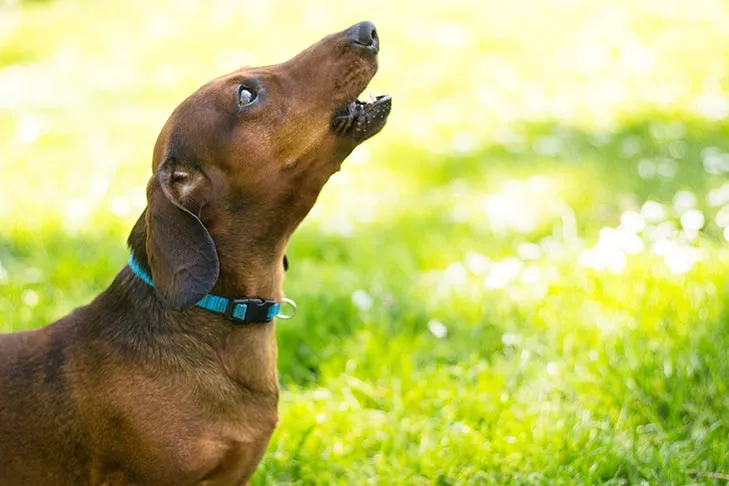 A Dachshund sits in the grass, head tilted back, howling or barking loudly.
A Dachshund sits in the grass, head tilted back, howling or barking loudly.
After several repetitions of marking and rewarding, your dog will begin to grasp that you are encouraging their barking behavior. To prevent nuisance barking, it’s crucial to ensure that once your dog understands the trick, you only reward them when they bark specifically in response to your verbal cue. This helps them differentiate between purposeful “speak” and excessive, unprompted barking.
How to Teach Your Dog Leg Weaves
Leg weaving is an impressive and dynamic trick that requires coordination from both you and your dog. Start in a spacious, safe area, and keep your dog off-leash to prevent tangling. Stand with your legs wide apart and have your dog positioned in front of you. Hold a treat in one hand behind your legs; this allows you to lure your dog through and around your legs more smoothly than pushing the treat from the front. Bend your knees slightly and use the treat to guide your dog to walk between your legs. Praise and treat as they pass through.
Once your dog is comfortable with this initial movement, use another treat to guide them through your legs and then around one leg until they return to their starting position in front of you. As you lure your dog, you can let them lick or nibble the treat to maintain their focus and position. Upon their return to the initial stance, offer enthusiastic praise and a treat.
When your dog confidently follows the treat through your legs and around one side, repeat the same steps to teach them to go through and around your other leg. Once your dog consistently follows the lure through your legs and around both legs individually, it’s time to link these movements into a continuous figure-8 pattern.
Begin by luring your dog between your legs and around your right leg, then immediately guide them around your left leg before finally rewarding them. Next, gradually fade out the treat lure by using an empty hand to guide your dog between and around your legs. When your dog can weave following your empty hand, introduce your verbal cue of choice, such as “weave” or “legs.” With continued practice, you can progressively phase out the empty-handed lure, and your dog will learn to recognize your bending-knee body language as the physical cue for the trick.
After mastering leg weaving while you’re standing still, you can advance to teaching them to weave while you walk forward. Start by taking large, slow steps as you cue your dog to weave. As you introduce movement, reintroduce the treat lure temporarily to help build your dog’s confidence. With more experience, you can gradually phase out the lure and begin walking faster with smaller steps to perfect this exciting trick. For more ideas, consider exploring the everything dog training and tricks book.
How to Teach Your Dog to Shake Hands
Teaching your dog to shake hands is a classic and charming trick. Begin by holding your hand out towards your dog. Initially, ignore any licking or sniffing. The moment your dog paws at your hand, immediately mark that behavior with praise or a click, and then reward them with a treat. Repeat this process until your dog consistently paws at your hand.
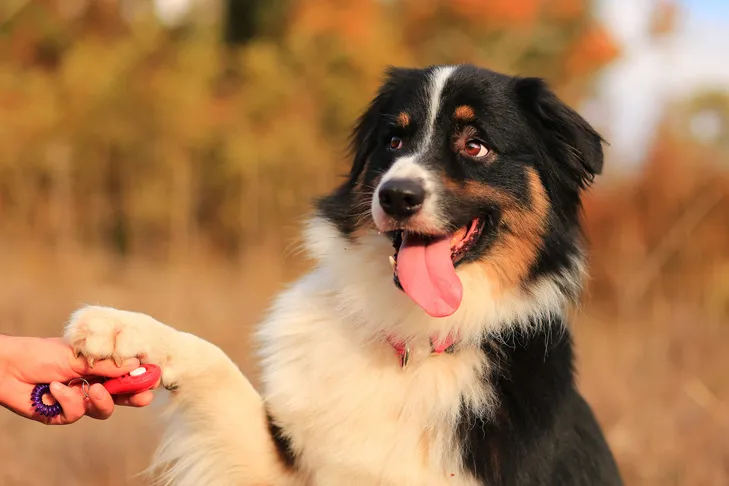 An Australian Shepherd outdoors, its paw resting gently in a person's outstretched hand, learning the 'give paw' trick.
An Australian Shepherd outdoors, its paw resting gently in a person's outstretched hand, learning the 'give paw' trick.
Next, start to build up the duration of time your dog’s paw rests on your hand. Wait until the paw is resting comfortably in your hand for a second or two before clicking or praising and rewarding. Gradually increase this duration as your dog gains understanding.
Once your dog reliably places their paw in your hand and waits for the reward, introduce a verbal cue like “shake” or “hello.” At this point, you can also flatten your hand and hold it vertically (with the treat concealed) in a motion similar to shaking a human’s hand. Begin to introduce a gentle, up-and-down movement with your hand before giving your dog the treat.
How to Teach Your Dog “Yes” and “No”
This clever trick gives the impression that your dog can respond “yes” or “no” to your questions. To teach your dog to “say yes,” hold a high-value treat within a closed fist (or use another simple hand signal of your choice). Slowly move the hand containing the lure up and down. As your dog follows the movement with their nose, their head will naturally nod. Reward them with the treat.
When your dog consistently follows your fist’s up-and-down motion, try performing the movement with an empty hand. When your dog nods, praise them and then give a treat with your other hand. After sufficient practice, your closed fist will become the physical cue for your dog to nod their head, and you can gradually phase out the actual up-and-down motion.
To teach your dog to “say no,” use a similar approach but with a distinct hand signal, such as a closed fist with your pointer finger extended upwards. To elicit a head shake, move your hand slowly from side to side. As your dog follows your hand, it will appear as if they are shaking their head. As soon as your dog moves their head to follow your hand, praise and treat. With practice, the raised finger will become the physical cue for your dog to shake their head. These tricks how to train your dog are excellent for cognitive engagement.
How to Teach Your Dog to Bow
The “bow” is an elegant trick that encourages stretching and builds core strength. Begin with your dog standing directly in front of you. Capture their attention with a treat in your hand. Then, use the treat to lure their nose down between their front legs and back towards their chest and belly. As your dog follows the treat, they will naturally lower their front end into a bow position, keeping their hindquarters raised. Praise and reward your dog, then toss a treat slightly away to encourage them to stand up, preventing them from simply collapsing into a “down.” Repeat this over several training sessions.
While luring and guiding between the front legs works for many dogs, some may struggle and simply move into a “down” position. If this occurs, Penny Leigh, CPDT-KA, Director of the AKC GoodDog Helpline (GDH), suggests lightly placing a hand or even just a finger on your dog’s stomach, just below the loin. This subtle cue helps them understand you are not asking for a full “down.”
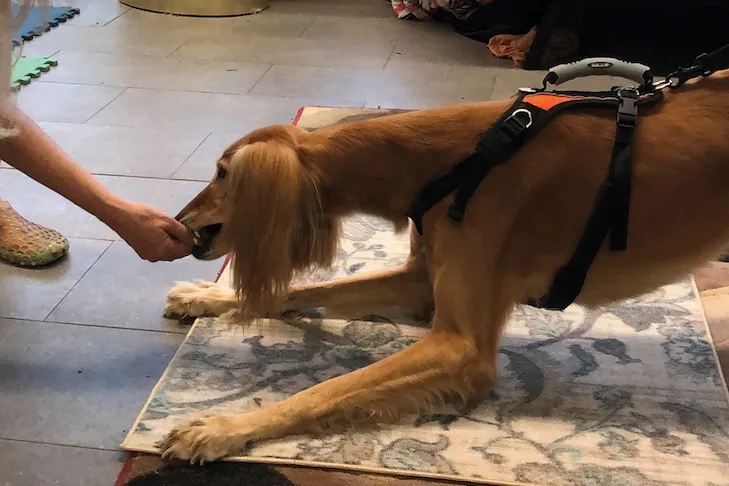 A dog, Pepe, a mixed breed, performs a graceful bow with its front legs extended and its hindquarters raised.
A dog, Pepe, a mixed breed, performs a graceful bow with its front legs extended and its hindquarters raised.
Once your dog consistently follows the food lure into the bow position, begin luring them with an empty hand. Reward your dog with a treat after they perform the bow. After your dog responds to the empty-hand lure, you can introduce a verbal cue of choice, such as “bow” or “fancy.” With consistent practice, your dog will develop the strength and coordination to hold the bow for longer durations. You can also gradually phase out your physical lure, eventually evolving the physical cue for this trick to you performing a slight bow or curtsy yourself.
How to Teach Your Dog to Make a Circle
Teaching your dog to spin or make a circle is a simple yet impressive trick. Begin by getting your dog’s attention with a treat or a favorite toy. Hold the lure just above your dog’s nose and then slowly move your hand in a large circular motion. As your dog follows the treat or toy, they will naturally walk in a circle. Praise and immediately reward your dog upon completion of the circle. After a few repetitions and when your dog consistently follows the lure in a circle, you can introduce your verbal cue of choice, such as “spin,” “twirl,” or “around.”
Next, use the same technique to lure your dog to spin in the opposite direction. Once your dog consistently follows your lure to spin the other way, add a distinct verbal cue for this direction. When your dog consistently responds to your cue in both directions, you can then perform the circular hand motion without a treat in your hand while simultaneously giving your verbal cue. Reward your dog with praise and a treat each time they spin correctly.
How to Teach Your Dog to Play Peekaboo
The “peekaboo” trick, where your dog comes and settles between your legs, is not only adorable but also a practical skill, especially when navigating crowded spaces or needing to keep your dog close. To teach this trick, stand in front of your dog, with both of you facing the same direction. Hold a treat in your hand to gain their attention. When your dog comes forward and settles between your legs, offer immediate praise and a treat.
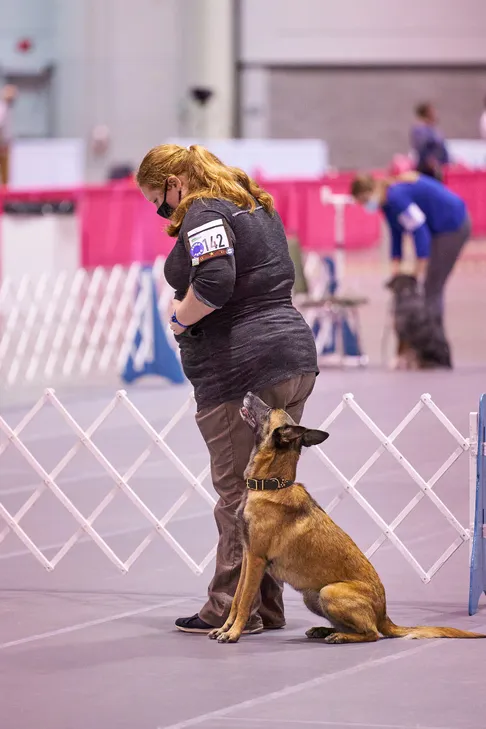 A dog, likely a sporting breed, is positioned between a person's legs, looking forward, demonstrating the 'peekaboo' or 'middle' trick.
A dog, likely a sporting breed, is positioned between a person's legs, looking forward, demonstrating the 'peekaboo' or 'middle' trick.
After several repetitions, you can introduce a verbal cue of your choice, such as “middle” or “peekaboo,” as your dog moves into position between your legs. Once your dog is comfortably settled, use your release cue (if you have one) or toss a treat to encourage them to move out of position, allowing you to practice again. With consistent practice, you will be able to fade out the need to lure your dog forward with a treat, and they will respond reliably to your verbal cue to come into the “peekaboo” position.
Start Your Dog’s Trick Training Journey Today!
Teaching dog tricks to train your dog is an enriching experience that benefits both of you. These advanced tricks not only impress but also deepen your bond, enhance communication, and provide valuable mental and physical exercise for your canine companion. Remember that patience, consistency, and positive reinforcement are key to success. Every dog learns at their own pace, so celebrate small victories and keep training sessions fun and engaging.
Ready to explore more ways to challenge your dog? Visit Dog Care Story for a wealth of resources on dog training, behavior, and care. Unleash your dog’s full potential and embark on a rewarding journey of learning and companionship!
